
* The Focke-Wulf "Fw 200 Condor" was conceived as a pioneering long-range airliner before the outbreak of World War II. The conflict ensured that the Fw 200's service as a commercial airliner would be minimal; it would instead be pressed into service in the maritime reconnaissance / anti-shipping attack role, largely for the lack of anything better available. Despite the fact that the Condor left much to be desired as a combat aircraft, it made a painful nuisance of itself to the Allies. This document provides a history and description of the Fw 200 Condor.
* In the 1930s, aircraft designers began to work on the problem of conducting airline operations across the Atlantic. While flying boats, making refueling stops along the route, could make the crossing, that was a clumsy scheme; it was preferable to build a landplane that had enough range to make the crossing from one airfield to another.
Aircraft designer Kurt Tank of the Focke-Wulf firm of Germany had ideas about such a long-range airliner, and proposed to Dr. Rudolf Stuessel of Deutsche Lufthansa (DLH, the state airline), that such a machine could be developed. In June 1936, The DLH issued a specification for a transcontinental airliner with a range of 3,000 kilometers (1,860 miles), for carrying mail or up to 26 passengers. Construction of an initial prototype of the "Fw 200 Condor" followed quickly, with this machine, the "Fw 200 V1" -- where "V" stood for "Versuchs (prototype)" and named SAARLAND -- taking to the air on 27 July 1937, after little more than a year of development, with Tank at the controls.
The Fw 200 was an elegant machine, of all-metal construction, except for fabric-covered flight-control surfaces and the wing covered with fabric aft of the main spar; it was powered by four radial engines mounted on a wide-span low-mounted wing. All flight control surfaces were manually actuated, though the split flaps were hydraulically actuated.
It had taildragger landing gear, all with single wheels, all gear retracting rearward, allowing the gear to fall open if power systems failed. The aircraft was not pressurized, limiting cruise altitude to 3,000 meters (9,800 feet). The V1 was powered by US-made Pratt & Whitney Hornet engines, providing 625 kW (875 HP), and driving two-bladed VDM-Hamilton propellers. At the time of its introduction, it was one of the most advanced airliners in the world.
The V1 was followed by two more prototypes, the "Fw 200 V2" and "Fw 200 V3", powered by German-made BMW 132G-1 engines -- which were licensed Hornets -- with 535 kW (720 HP) each. The prototypes were followed in turn by nine "Fw 200A-0" pre-production aircraft -- these nine aircraft had "Versuchs" prototype numbers. They ended up in the hands of Lufthansa, Danish Air Lines, and the Syndicato Condor airline of Brazil.
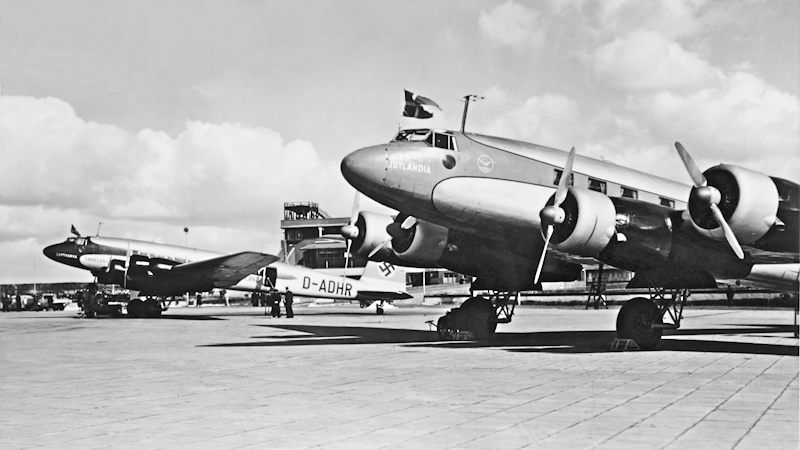
The prototypes and early production machines were also used by Nazi officials as VIP transports; German Foreign Minister Joachim von Ribbentrop flew the Condor twice to Moscow in 1939, in the course of negotiations for the cynical Nazi-Soviet Non-Aggression Pact. The V3 prototype later became Adolf Hitler's personal transport, replacing a Junkers Ju 52. Its airliner fittings were swapped out for a plush two-cabin VIP configuration; Hitler's seat was equipped with a wooden table, seat-back armor plating, and an automatic parachute system. It was named IMMELMANN III, in honor of World War I ace Max Immelmann. The aircraft was destroyed at Berlin's Tempelhof Airport by an Allied bombing raid on 18 July 1944.
BACK_TO_TOP* To promote the Condor and German technical capability, the V1 prototype was fitted with extra fuel tanks and used to perform long-range flights. The machine was redesignated "Fw 200S" -- "S" effectively for "special" -- and named BRANDENBURG for these flights. On 10:11 August 1938, it became the first heavier-than-air machine to fly non-stop between Berlin and New York City, the journey taking 24 hours and 56 minutes, headwinds delaying arrival; the return flight on 13 August took 19 hours and 47 minutes.
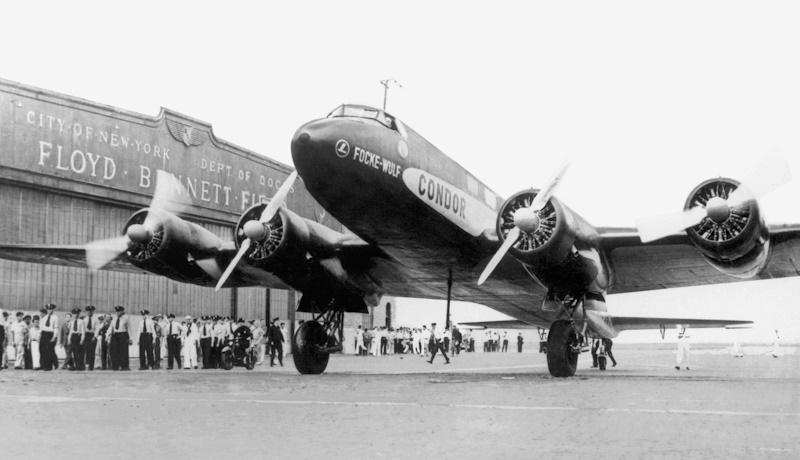
Starting on 28 November 1938, the Fw 200S-1 flew from Berlin to Tokyo via Basra, Karachi, and Hanoi, the trip taking 46 hours 19 minutes. Although it had to ditch in the shallows off Manila on the way back after running out of fuel, the Japanese were impressed by the aircraft, and ordered four civil airliners, plus a single machine in a maritime reconnaissance configuration. The airliners were ordered by Dai Nippon KK airlines, with the Imperial Japanese Navy ordering the maritime reconnaissance machine with a secret contract.
The Focke-Wulf firm had been moving towards the full-production "Fw 200B" airliner at the company's factory in Bremen. However, the DLH wasn't focused on long-range routes, and did not order the Fw 200B. The four airliners for the Japanese order were built to two configurations:
The maritime reconnaissance machine was built as the "Fw 200 V10", originally having been the prototype for the Fw 200B series. It had 60% more fuel capacity, a ventral gondola offset to the right, and defensive armament of three MG 15 7.9-millimeter (0.31-caliber) machine guns -- one gun in a dorsal turret aligned with the trailing edge of the wing, and one on a trainable mount at each end of the ventral gondola. It could carry 2,000 kilograms (4,400 pounds) of stores and mission equipment. The offensive warload was four 250-kilogram (550-pound) bombs, all carried externally, one under each (extended) outer nacelle, and one on a rack on the outboard wing. It also had two vertical cameras in the center fuselage.
These five machines -- and two more airliners ordered by Aero OY of Finland -- were never delivered, due to the outbreak of war in September 1939. The six Fw 200B airliners went into DLH and Luftwaffe service. Only one would survive to the end of World War II.
* Just before the outbreak of war, Oberstleutnant Edgar Petersen was authorized by the top brass of the Luftwaffe, the German air force, to set up a specialized maritime reconnaissance unit. In preparation for the war, the Luftwaffe had focused on acquisition of twin-engine bombers, and did little to acquire a long-range heavy bomber or reconnaissance aircraft. That meant Petersen had to take what he could get; he evaluated the militarized Fw 200 V10, and decided it was the right tool for the job. The first of an eventual ten "Fw 200C-0" pre-production machines -- altered from Fw 200B aircraft on the production line and with BMW 132H engines -- was delivered in September 1939.
Of the ten, the initial four were unarmed transports, having been too far advanced in manufacture to make it worthwhile to build into the maritime reconnaissance configuration. The only major differences from their predecessors were a modest amount of structural strengthening, longer engine cowlings, three-bladed props, and twin-wheel main gear -- these changes being retained in all following Condor variants.
Along with impressed Fw 200Bs, the Fw 200C transports were operated by the Luftwaffe in the invasion of Norway in 1940. Incidentally, the Scandinavian campaign began with the quick and bloodless occupation of Denmark; one consequence of this was that one of the Danish Fw 200s, then on English soil, was seized by the British. It was operated by the British Overseas Airways Corporation (BOAC), then pressed into service with the Royal Air Force -- to be damaged and written off in 1941.
The six maritime patrol Fw 200C-0s were like the Fw 200 V10. They seeded Petersen's maritime reconnaissance wing, Kampfgeschwader 40 (KG 40), which began patrol operations out of Bremen in October 1939 -- with KG 40 moving to Denmark after that country's occupation, conducting patrols from Danish bases from April 1940. Although other organizations would fly the Condor operationally, KG 40 would be the primary user.
Attrition was high, with KG 40 giving up operations in June to re-fit with the first full production military variant, the "Fw 200C-1", which entered service that month. The Fw 200C-1 had a crew of five and was powered by BMW 132H engines, providing 620 kW (850 HP) each. The ventral gondola was lengthened to accommodate a munitions bay, with a potent MG FF 20-millimeter cannon on a trainable mount in the front; the Fw 200C-1 also had single MG 15 7.92-millimeter machine guns on trainable mounts in forward and aft dorsal positions, plus the rear of the ventral gondola, for a total of four guns.
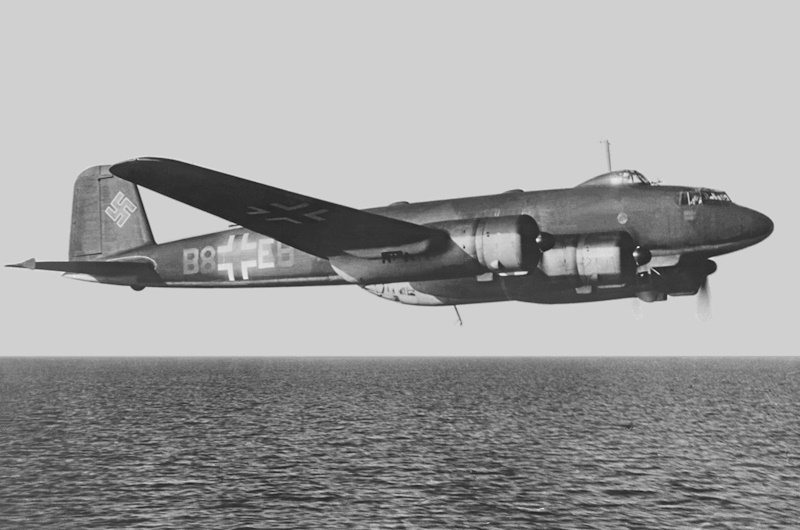
As with the Fw 200C-0, offensive warload was four 250-kilogram bombs, carried under the outboard engine nacelles and outer wings. The bomb under each outboard engine nacelle could be traded for a standard Luftwaffe 300-liter (79 US gallon) external tank, extending range but cutting the offensive warload in half. A 250-kilogram concrete bomb could also be carried in the ventral gondola, this item having the same ballistic characteristics as the real thing, being used to calibrate the bombsight. The Fw 200C-1 was also used as an aerial minelayer, carrying two 450-kilogram (1,000-pound) mines, and on occasion as a general-purpose bomber.
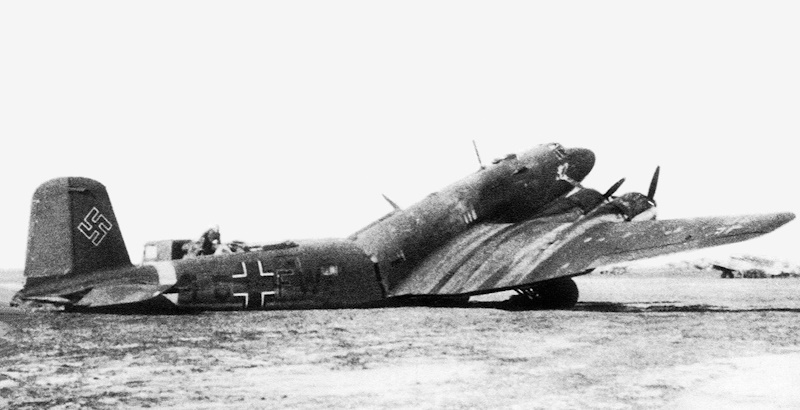
Normal crew was five, including pilot; copilot; and three gunners, with one gunner being the flight engineer, and another serving as both radio operator and navigator. The aircraft was roomy and heating was adequate, but crews were not happy with the light defensive armament, and particularly unhappy with the weak airframe. Attrition of aircraft was high, the Condor having a particularly nasty tendency to break its back on landings.
BACK_TO_TOP* In late June 1940, KG 40 relocated from Denmark to recently-defeated France, setting up a primary base at Bordeaux-Merignac, conducting sweeps from the Bay of Biscay, around the British Isles -- to land in Trondheim, Norway, the satellite operational base for KG 40. From July, they were diverted to contribute their small weight to the Luftwaffe aerial assault on the Britain, performing night attacks in the Liverpool-Birkenhead area. It was a sign of the strain on Luftwaffe resources to sustain the air assault on the UK that it was seen as necessary to employ the Fw 200 in a role for which it was poorly suited.
It wasn't until August that the Condors got properly settled in their proper mission of anti-shipping strike, sinking 90,000 tonnes (99,000 tons) of Allied shipping in two months -- coming in at low level to "bracket" a target with multiple bombs. On 26 October, a Condor piloted by Oberleutnant Bernhard Jope scored a particular coup by crippling the 38,418-tonne (42,348-ton) liner EMPRESS OF BRITAIN southwest of Donegal. The vessel was taken under tow, but then finished off by a U-boat.
By early February, Condors had claimed almost a hundred vessels totaling 363,000 tonnes (400,000 tons) of Allied shipping -- despite the fact that the Fw 200's numbers were relatively small, and aircraft in service continued to suffer from a high rate of attrition. Maybe a dozen or so Condors were in service with KG 40 at any one time; they still raised enough hell so that British Prime Minister called the Fw 200 the "scourge of the Atlantic". It demonstrated the reality that a merely workable weapon is much better than no weapon, particularly if an adversary has little to counter it.
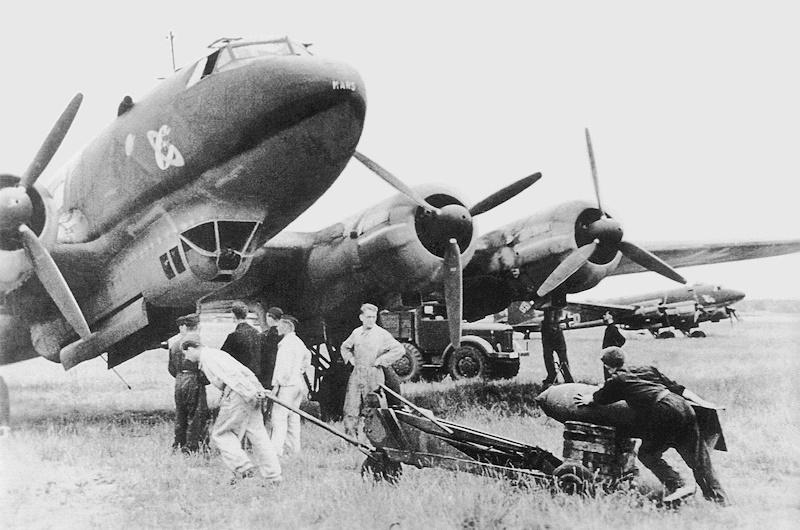
Focke-Wulf, in an effort to build more Fw 200s, dispersed manufacturing at five plants, with final assembly at Bremen and Cottbus, as well as by Blohm und Voss at Finkenwerder. However, the Fw 200 was a low priority, and deliveries were in penny packets, delays being aggravated by damage from British bombing raids to the Bremen plant. The next version of the Condor, the "Fw 200C-2", was no great advance over the Fw 200C-1, the major change being to alter the outboard engine nacelles for the semi-recessed carriage of a 250-kilogram bomb. The outboard bomb racks were not deleted, but were faired over.
* The Fw 200C-2 was followed by the "Fw 200C-3", which was introduced in the summer of 1941, being an earnest attempt to address the Condor's weaknesses. It featured:
The Fw 200C-3's added warload and defensive armament of course raised maximum take-off weight, meaning the airframe reinforcement was, to an extent, a case of running as fast as one could to stay in one place.
___________________________________________________________________
FOCKE-WULF FW 200C-3/U4 CONDOR:
___________________________________________________________________
wingspan:
32.85 meters (107 feet)
wing area:
118.95 sq_meters (1,290.1 sq_feet)
length:
23.45 meters (76 feet 11 inches)
height:
6.3 meters (20 feet 8 inches)
empty weight:
17,005 kilograms (37,490 pounds)
max take-off weight:
24,520 kilograms (50,057 pounds)
max speed at altitude:
360 KPH (225 MPH / 195 KT)
cruise speed:
335 KPH (210 MPH / 180 KT)
service ceiling:
6,000 meters (19,700 feet)
range:
3,560 kilometers (2,212 MI / 1,925 NMI)
endurance:
14 hours
___________________________________________________________________
There were a number of subvariants of the Fw 200C-3, derived from "Umruest-Bausaetze" or "factory conversion kits", designated by a "U" code -- each kit providing a set of mods to be implemented in production, or apparently sometimes in field depot maintenance. The subvariants included:
The introduction of the Fw 200C-3 actually coincided with the decline of the Condor. It was much too vulnerable to enemy fighters. From the summer of 1941, to defeat the Condor menace, the British started launching Hawker Hurricane fighters off rocket catapults, mounted on merchant ships. The "Catapult Armed Merchantman (CAM)" ship concept was a dodgy improvisation, but it was soon replaced by British Royal Navy escort carriers, with Grumman Wildcat fighters, that proved much more effective.
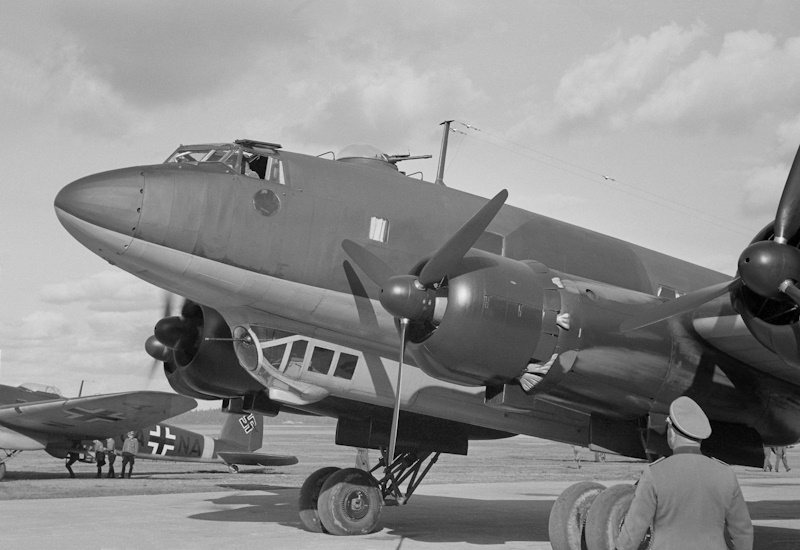
The enhanced defensive armament introduced on the Fw 200C-3 did little to improve its survivability. Even RAF Short Sunderland flying boats would take it on, with a good chance of a kill. While the Fw 200 continued to perform oceanic patrols, it was largely on a reconnaissance basis; aircraft commanders were told to avoid direct combat, instead radioing in the position of an Allied convoy for attack by U-boats or other assets. The Condor force was also hampered by the occasional reassignment of aircraft to transport duties -- another sign of strain on the resources of the German war machine.
BACK_TO_TOP* In early 1942, Focke-Wulf did introduce a new patrol variant, the "Fw 200C-4", the primary change from the Fw 200C-3 being introduction of search radar, initially the preliminary FuG Rostock set, and then the production FuG 200 Hohentwiel set -- the Hohentwiel also having a "blind bombing" capability to permit attacks on ships in low-visibility conditions. Some Condors would have both sets, the Rostock having a wider field of view and greater range than the Hohentwiel, but longer minimum range, meaning it couldn't be used for blind bombing. With the radar, the Condor could search for Allied shipping and perform attacks in murky weather that concealed the aircraft from Allied fighters. Surviving Fw 200C-3 machines were generally refitted with radar.
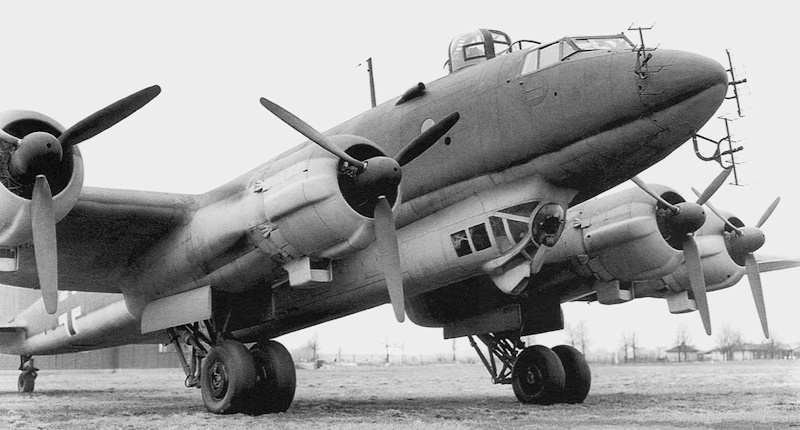
The Fw 200C-4 also featured the big HDL 151 turret, with an MG 151/15 15-millimeter cannon, in the forward dorsal position; and the MG 131 machine gun, along with the Lofte bombsight, in the front of the ventral gondola. The MG 131 and the bombsight could be removed and replaced with an MG 151/20 20-millimeter cannon if needed. The guns in the rear dorsal, rear ventral gondola, and beam positions were all, as per tradition, MG 15s. The Fw 200C-4 was the most heavily produced Condor variant.
The Fw 200C-4 was something of a wasted effort, however, since Fw 200s were increasingly assigned to transport duties, not maritime patrol, with Condors being used in early 1943 in the attempt to fly in supplies to German forces encircled at Stalingrad. Eventually, the landing field at Stalingrad was abandoned to the Soviets, and so the Condors performed parachute drops, with four canisters under the wings, and then were shifted to night bombing duties on rail junctions.
There were two one-off modifications of the Fw 200C-4:
Both had a shortened ventral gondola and armament of four MG 15 7.92-millimeter machine guns -- one in the front of the ventral gondola, the second in the rear of the gondola, the third in an FW 19 turret in the forward dorsal position, and one in an FW 20 turret in the rear dorsal position.
A number of Fw 200C-3/U1 and Fw 200C-3/U2 aircraft were adapted to carry a single Henschel Hs 293 anti-ship missile under each outer engine nacelle, the aircraft being fitted with a FuG 203b Kehl radio transmitter to control the bomb. The missile had a flare on its tail to allow the bombardier to track it, with the bombardier steering it with a hand controller; the transmitter had multiple channels to allow multiple missiles to be controlled at the same time by different launch aircraft. These conversions were designated "Fw 200C-6".
There were also a handful of new-build "Fw 200C-8", with Hohentwiel search radar and ventral gondola extended forward, at least some of them being fitted out as missile launchers. The Condor missile-carriers were introduced in December 1943, but they did not prove successful; the Germans used the Hs 293 effectively against Allied shipping in the Mediterranean early on, but the British quickly came up with radio jammers that rendered the weapon ineffective.
By that time, the Condor had been generally replaced by the much better Junkers Ju 290 in the maritime patrol role. Fw 200s were still called out to perform strikes on targets that had been spotted by other resources -- performing attacks, and then returning promptly to base. The Allied invasion of France in June 1944 meant the evacuation of KG 40's base at Bordeaux-Merignac, and the effective end of the Fw 200's offensive duties The Condor was relegated to the transport role, with a handful remaining operational to the end of the war.
The last Condor was built in 1944, a total of 276 having been produced -- 10 airliners and 262 military Condors, the military total not counting the four impressed Fw 200B airliners. The only foreign operator of military Condors was Spain, which interned four that had landed there after the Allied invasion of North Africa in the fall of 1942. The crews were allowed to go back to Germany, with Spain paying the Reich for the aircraft. Three of them were in flying condition and served with the Spanish Air Force for several years after the war.
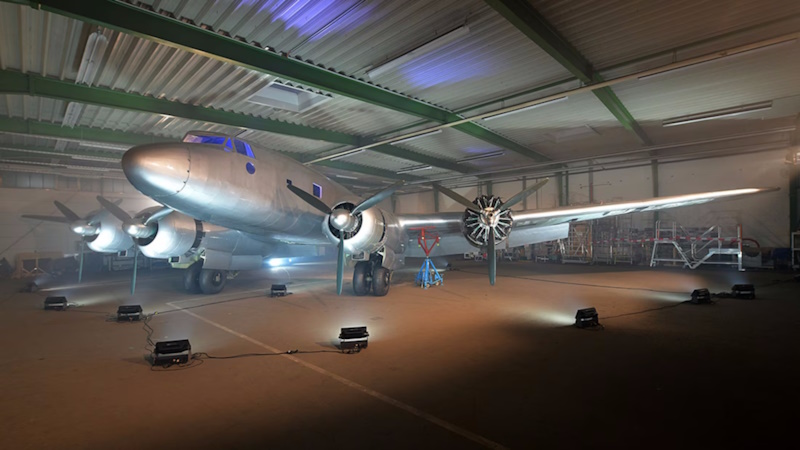
Only one Condor has survived, having been raised from the bottom of Trondheim Fjord in Norway in 1999. It was being restored by the German Museum of Technology in Berlin, leveraging off assemblies of other Condor wrecks, and going on display in 2021 in a museum at what used to be Tempelhof Airport in Berlin. Although the wreck had been of an Fw 200C-4, it was restored as an airliner.
BACK_TO_TOP* Sources include:
* Image credits:
* Revision history:
v1.0.0 / 01 jun 16 v1.0.1 / 01 may 18 / Review & polish. v1.2.0 / 01 oct 24 / Reformatting, illustrations update. (+)BACK_TO_TOP
